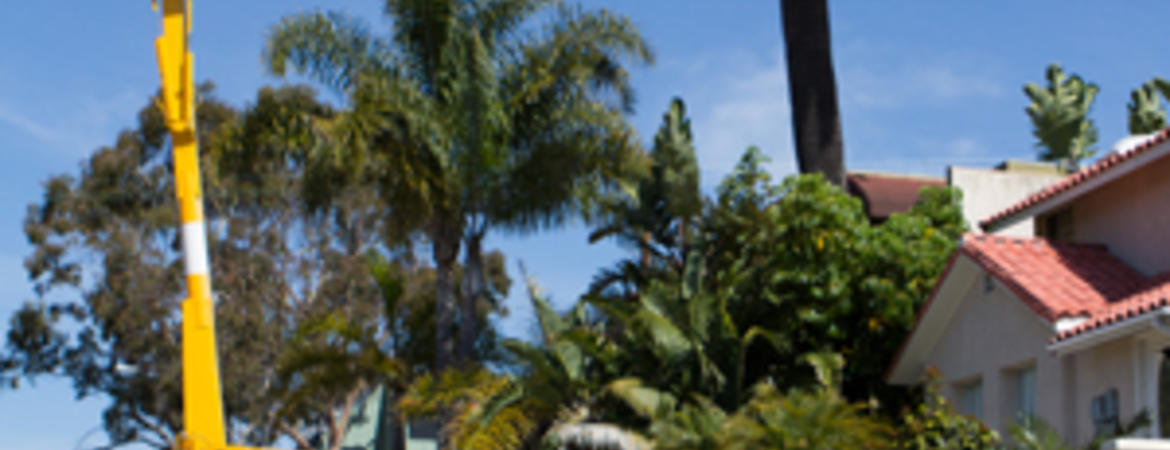
On June 2 2011, a second Canary Islands palm was inspected for red palm weevil in Laguna Beach, approximately one week (May 25 2011) after the first palm suspected to be infested with red palm weevil was inspected and confirmed to have red palm weevil activity, and subsequently treated with insecticides.
The process for selecting and treating palms at Laguna Beach has followed a strict process: (1) Palms with suspected red palm weevil damage (figure “7” notches and straight edges on the tips of fronds, or the presence of pupal cocoons lying on the ground underneath palms) were identified from visual surveys conducted on the ground. These palms were recommended for secondary inspection. (2) Detailed secondary visual inspection of suspect palms required the cutting of an observation window to access the central growing area of the palm to look for red palm weevil feeding damage. This is a highly favored feeding and breeding site. During frond removal to create the observation window, cut palm fronds were examimed for weevil feeding damage, the presence of pupation chambers and cocoons, and live and dead life stages, especially pupae and adults. (3) Confirmation of red palm weevil infestation (e.g., the presence of pupal cocoons in the tree, feeding tunnels made by larvae, or body parts of dead adults) based on the detailed secondary inspection triggered pesticide applications to control the pest population in the palm. This three step evaluation process culminating with the ultimate decision to treat with insecticides involved representatives from the Orange County Agricultural Commissioner’s Office, CDFA, USDA and local (UC Riverside), national (University of Florida), and international University (Spain and Israel) experts.
At the Pacific Coast Highway site, approximately 10 lower-level fronds on this palm were either dead or dying, and about 5-7 additional fronds exhibited red palm weevil feeding damage (i.e., the terminal ends of fronds were straight-across instead of pointed and figure “7” notches were present). Because of this easily observed visual damage, this palm was thought to be infested with red palm weevil and was prioritized for seconday inspection and if weevil activity was obvious, treatments would be applied.
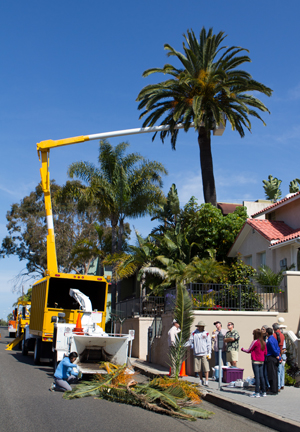
This inspection and treatment event was organized by Dr. John Kabashima (UCCE) and was attended by Dr. Mark Hoddle (UC Riverside), Laura Petro and Mohammed Alzubaidy (both CDFA), Nick Nisson (Orange County Entomologist), Roger Peterson (Approved Tree Care), Will Harrison (Target Specialty Products), and Chuck Galanti (MPA Landscape Services).
Starting at 8:00am, Caltrans closed one northbound lane of the Pacific Coast Highway (PCH) to allow Approved Tree Care to set up a bucket lift to access the crown of the potentially infested palm. UC Riverside Entomologist, Mark Hoddle, with the assistance of an Approved Tree Care employee maneuvered the bucket approximately 25-30 feet above the PCH to reach the palm crown. An observation window was cut into the crown and approximately 12 palm fronds and around 5 fruit bunches were removed from the crown to create the window. None of the fronds cut from the palm showed evidence of red palm weevil tunneling, pupation chambers, or empty cocoons.
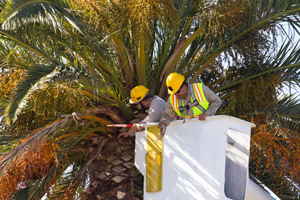
Inspection of the cut bases of fronds that had been removed previously during routine maintenance revealed the presence of old red palm weevil cocoons, and empty tunnels made by feeding larvae. The body parts of one dead adult red palm weevil were found. This dead adult weevil was red and black, the same color morph that has been found at other sites in Laguna Beach.
NO LIVE RED PALM WEEVIL LIFE STAGES WERE FOUND DURING THESE INSPECTIONS.
All material cut from the palm was chipped on site and transported to a local landfill to be buried.
The inspection window was treated with the maximum label rate of bifenthrin (donated by Target Specialty Products). Bifenthrin is a contact insecticide. It will kill red palm weevils by direct contact should wet spray hit the weevils, or if weevils move into the palm after the application they may be killed when they contact dried residues. This product provides immediate protection to cut areas of the palm that red palm weevil may find attractive and attack.
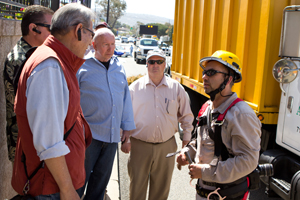
A second insecticide, 5% imidacloprid, was hand-injected with an Arbor-Systems Wedgle Direct-Inject System into the trunk about 0.5 m above the ground. Imidacloprid is a slow moving systemic insecticide and it will move from the point of injection through the trunk of the palm to the crown where red palm weevil larvae and adults may be feeding.
Injection needles were gently knocked into the trunk with a spacing of approximately six inches around the entire circumference. One hand-squeeze of the Direct-Inject System applied 1 ml of product through each needle into the trunk. Needles were removed following injections and sanitized prior to reuse. Trunk injections were made by Will Harrison, Target Specialty Products.
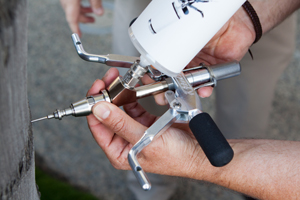
A third insecticide, dinotefuran, a fast moving systemic, was hand sprayed onto the trunk of the palm from ground level to a height of approximately 2 meters by a certified arborist from Approved Tree Care. This product will move quickly across the bark to enter the nutrient transport system of the palm which will move it to the crown where red palm weevil larvae and adults may be feeding. It is anticipated that this product will reach the crown more quickly than imidacloprid, but its persistence in the crown will not be particularly long. Although it is thought that imidacloprid will take longer to reach the crown than dinotefuran, it will last for significantly longer thereby increasing the time the palm will be protected internally from red palm weevil.
The CDFA collected palm foliage prior to the application of pesticides to test for insecticide residues. These analyses will provide the base line against which the concentration of the products applied today will be compared. The CDFA intends to take monthly foliage samples to test for imidacloprid and dinotefuran to determine how quickly and in what concentrations these insecticides occur in the foliage of this treated palm post-treatment. These data (especially the concentrations of the insecticides) will tell us how effective treatments may have been for controlling red palm weevil in this palm.
A pheromone bucket trap for red palm weevil was set at this site to trap adults that may fly to this palm. Every two weeks the CDFA will look for red palm weevil activity in the palm crown through the observation window.
For more information on Red Palm Weevil, visit the CISR website